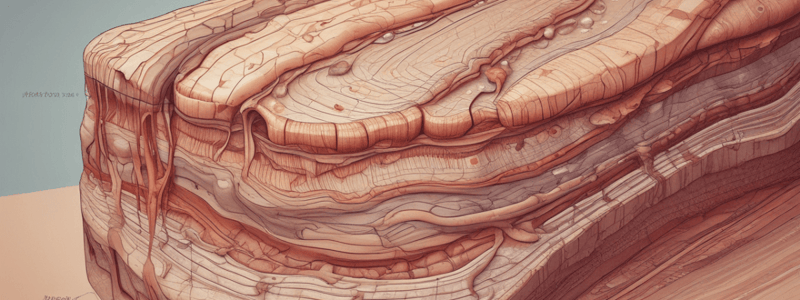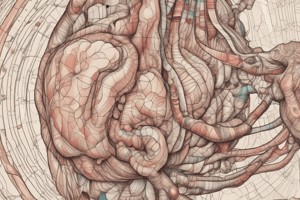Podcast
Questions and Answers
What is the topmost layer of the dermis called?
What is the topmost layer of the dermis called?
- Papillary dermis (correct)
- Stratum basale
- Reticular dermis
- Hypodermis
What type of tissue is found in the epidermis?
What type of tissue is found in the epidermis?
- Muscle tissue
- Connective tissue
- Epithelial tissue (correct)
- Nervous tissue
Which of the following proteins is most commonly associated with connective tissue?
Which of the following proteins is most commonly associated with connective tissue?
- Chitin
- Melanin
- Elastin (correct)
- Keratin
What is the primary function of connective tissue?
What is the primary function of connective tissue?
Which layer of the skin is located directly below the epidermis?
Which layer of the skin is located directly below the epidermis?
What is the layer below the papillary dermis known as?
What is the layer below the papillary dermis known as?
Which of the following is NOT a component of connective tissue?
Which of the following is NOT a component of connective tissue?
What distinguishes the dermis from the epidermis?
What distinguishes the dermis from the epidermis?
What is another name for the hypodermis?
What is another name for the hypodermis?
Which of the following best describes the primary function of fat in the hypodermis?
Which of the following best describes the primary function of fat in the hypodermis?
What is the degree of burn that primarily affects the epidermis?
What is the degree of burn that primarily affects the epidermis?
How does a second-degree burn differ from a first-degree burn?
How does a second-degree burn differ from a first-degree burn?
Which layer of the skin sits directly below the dermis?
Which layer of the skin sits directly below the dermis?
What characterizes a third-degree burn?
What characterizes a third-degree burn?
What is the primary reason that fat in the hypodermis is important for shock absorption?
What is the primary reason that fat in the hypodermis is important for shock absorption?
Which of these statements about burns is correct?
Which of these statements about burns is correct?
What lies directly beneath the hypodermis?
What lies directly beneath the hypodermis?
Why might individuals with more subcutaneous fat withstand traumatic injuries better?
Why might individuals with more subcutaneous fat withstand traumatic injuries better?
What is the primary function of loose connective tissue in the papillary dermis?
What is the primary function of loose connective tissue in the papillary dermis?
What do capillaries in the papillary dermis primarily supply to the epidermis?
What do capillaries in the papillary dermis primarily supply to the epidermis?
What is the main role of the dense connective tissue in the reticular dermis?
What is the main role of the dense connective tissue in the reticular dermis?
Which type of tissue does the epidermis rely on for nourishment?
Which type of tissue does the epidermis rely on for nourishment?
What sensory functions do the nerve endings in the dermis primarily serve?
What sensory functions do the nerve endings in the dermis primarily serve?
The arrector pili muscle is associated with which type of bodily response?
The arrector pili muscle is associated with which type of bodily response?
Which of the following structures is NOT found in the reticular dermis?
Which of the following structures is NOT found in the reticular dermis?
What function do sweat glands serve that are anchored in the reticular dermis?
What function do sweat glands serve that are anchored in the reticular dermis?
What type of connective tissue is specifically noted for its density in the reticular dermis?
What type of connective tissue is specifically noted for its density in the reticular dermis?
How does the epidermis receive oxygen and nutrients, given that it does not have its own blood supply?
How does the epidermis receive oxygen and nutrients, given that it does not have its own blood supply?
Flashcards are hidden until you start studying
Study Notes
Skin Structure Overview
- Skin comprises three layers: epidermis (outer), dermis (middle), and hypodermis (bottom).
- The epidermis’s basal layer is known as the stratum basale.
Dermis Layers
- The dermis has two layers:
- Papillary dermis (topmost)
- Reticular dermis (below the papillary dermis)
Tissue Types
- Epidermis consists of epithelial tissue.
- Dermis is made up of connective tissue, which contains various proteins (e.g., collagen, elastin).
- Connective tissue helps to hold structures together unlike the cellular nature of epithelial tissue.
Papillary Dermis
- Composed of thin, loose connective tissue supporting flexibility.
- Contains capillaries that provide oxygen and nutrients, necessary for epidermis nourishment.
- Nerve endings present, allowing sensation of touch and pain.
Reticular Dermis
- Features thicker, denser connective tissue to provide stability.
- Anchors structures like sweat glands and hair follicles, which extend to the epidermis.
- Contains arrector pili muscles, which cause hair to stand up in response to cold or fear.
Hypodermis
- Also known as subcutaneous fat, it sits below the dermis.
- Functions to absorb shock and insulate body tissues.
- Separates skin layers from underlying muscle and bone.
Clinical Relevance: Burns
- Burns classified into degrees based on skin layer involvement:
- First-degree burn: affects only the epidermis, causes redness and pain.
- Second-degree burn: extends into dermis, may not hurt due to nerve tissue damage.
- Third-degree burn: reaches hypodermis and underlying tissues (fat, muscle, bone), often painless with darker coloration.
- Understanding these layers assists in diagnosing burn severity.
Studying That Suits You
Use AI to generate personalized quizzes and flashcards to suit your learning preferences.





